SRM-AP All News
ALL News
- Dr Tousif Khan published in Springer Nature June 20, 2022
The Department of Electrical and Electronics Engineering is proud to announce that the estimable book of Springer Nature, ‘Soft Computing: Theories and Applications’ has featured three publications by Dr Tousif Khan, Assistant Professor. His publications are part of the book series, Lecture Notes in Networks and Systems (LNNS), Volume 425. The book stimulates discussions on various emerging trends, innovations, practices, and applications in the field of soft computing, ranging from data mining, prediction analysis, control systems, image processing, health care, medicine, agriculture analysis, supply chain management and cryptanalysis etc.
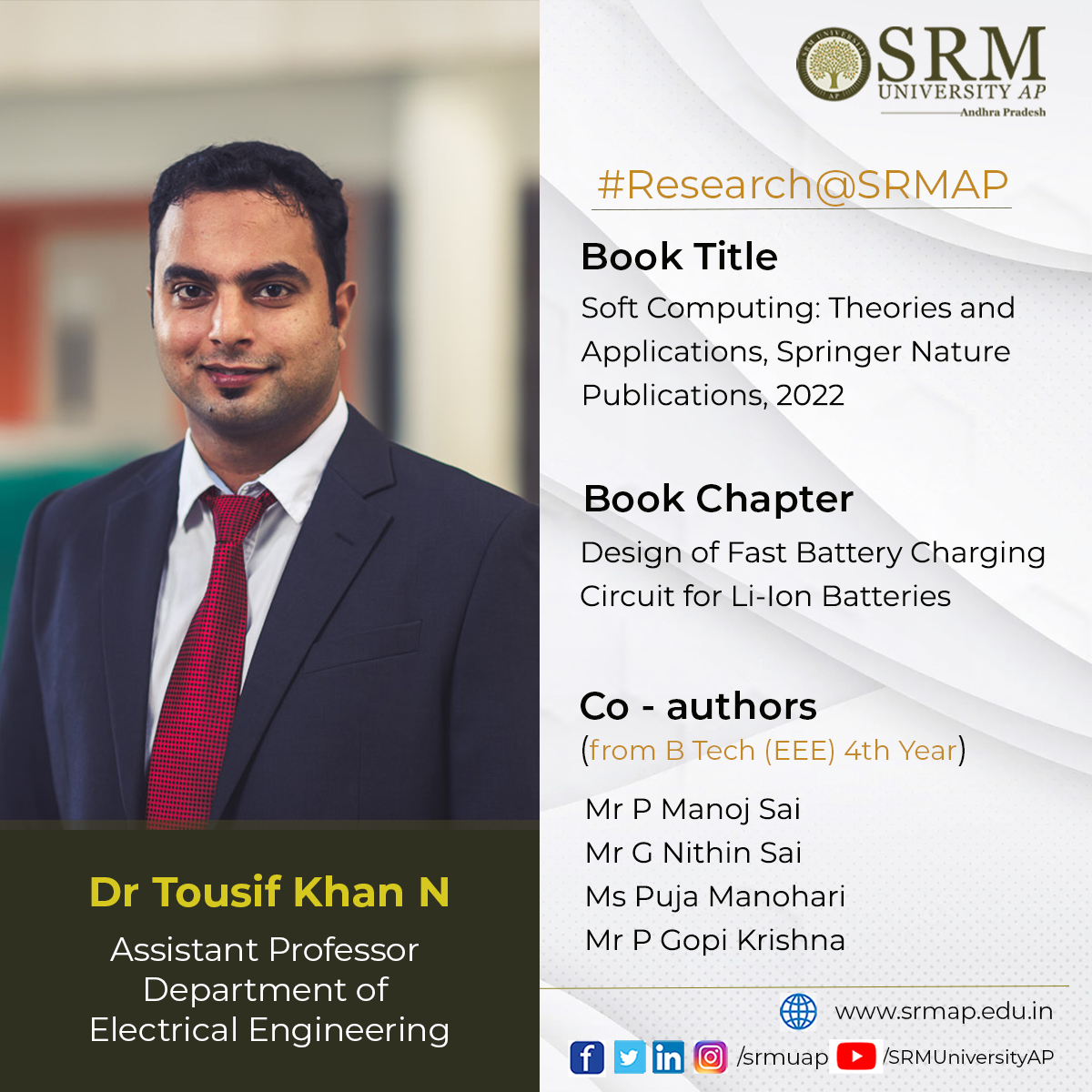 The first chapter titled “Design of Fast Battery Charging Circuit for Li-Ion Batteries” was co-authored by Dr Khan along with the final year EEE students; P Manoj Sai, G Nithin Sai, Puja Manohari, and P Gopi Krishna. In this chapter, a battery charging topology has been designed and developed for the fast charging of Li-ion batteries. The charging circuitry comprises a Proportional-Integral-Derivative (PID) controlled DC-DC buck converter system for reducing the charging time in Li-ion batteries. Battery charging time depends on several factors and the charging current is one of the major criteria. In this work, the buck converter is used to attain a high charging current, besides providing the regulated voltage to the battery. Initially, the AC supply obtained from the mains is converted to DC using an AC-DC rectifier. The rectifier output is further fed to the buck converter to increase the output current of the circuit. The buck converter reduces the output voltage and increases through it.
The first chapter titled “Design of Fast Battery Charging Circuit for Li-Ion Batteries” was co-authored by Dr Khan along with the final year EEE students; P Manoj Sai, G Nithin Sai, Puja Manohari, and P Gopi Krishna. In this chapter, a battery charging topology has been designed and developed for the fast charging of Li-ion batteries. The charging circuitry comprises a Proportional-Integral-Derivative (PID) controlled DC-DC buck converter system for reducing the charging time in Li-ion batteries. Battery charging time depends on several factors and the charging current is one of the major criteria. In this work, the buck converter is used to attain a high charging current, besides providing the regulated voltage to the battery. Initially, the AC supply obtained from the mains is converted to DC using an AC-DC rectifier. The rectifier output is further fed to the buck converter to increase the output current of the circuit. The buck converter reduces the output voltage and increases through it.The circuit parameters are designed by considering the commercially available Lithium-ion battery LIR18650 as the load with a capacity of 2600 mAh and a nominal voltage of 3.7 V. The considered battery requires a standard charging current of 0.5 A, however, the circuit is designed to provide the rapid charge current of 1.3 A as the output by using the buck converter. The converter is operated in continuous conduction mode and helps in charging the battery under constant current mode. To avoid interruption to the charging current when there is a simultaneous discharge of the battery, further improvement in the closed-loop control action is made by employing a PID controller. Extensive simulation work has been conducted using the MATLAB/Simulink tool. The results obtained suggest there is a significant reduction in charging time under different conditions compared to the conventional method of battery charging.
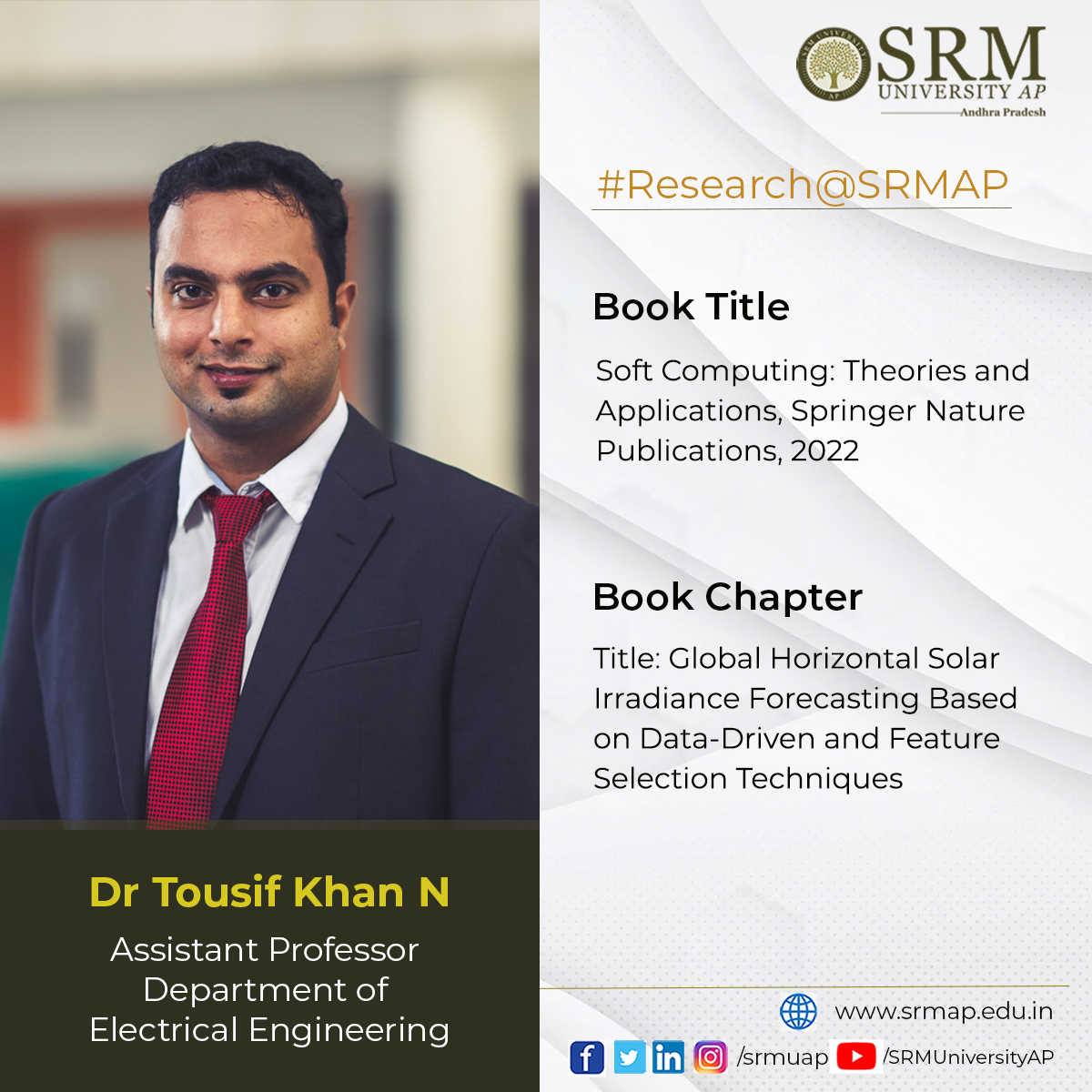 In the chapter, “Global Horizontal Solar Irradiance Forecasting Based on Data-Driven and Feature Selection Techniques”, Dr Khan discusses the need for an accurate solar prediction. It has become an essential part of the renewable energy sector with the rapidly expanding infrastructure of the solar energy system. Over the past decade, various machine learning (ML) algorithms have been used for this purpose. Although the prediction of solar irradiance forecasting has been discussed in many studies, the use of meta-heuristic optimization techniques has not been explored to select features for the forecasting model. This study comprises two meta-heuristic optimization techniques such as simulated annealing (SA) and ant colony optimization (ACO) for feature selection. The results show that feature selection based on meta-heuristics gave better results than models without feature selection.
In the chapter, “Global Horizontal Solar Irradiance Forecasting Based on Data-Driven and Feature Selection Techniques”, Dr Khan discusses the need for an accurate solar prediction. It has become an essential part of the renewable energy sector with the rapidly expanding infrastructure of the solar energy system. Over the past decade, various machine learning (ML) algorithms have been used for this purpose. Although the prediction of solar irradiance forecasting has been discussed in many studies, the use of meta-heuristic optimization techniques has not been explored to select features for the forecasting model. This study comprises two meta-heuristic optimization techniques such as simulated annealing (SA) and ant colony optimization (ACO) for feature selection. The results show that feature selection based on meta-heuristics gave better results than models without feature selection.Amongst the two optimization methods, ACO outperformed SA with some exceptions. For SA, the declining order of performance observed is extreme gradient boosting (XGBoost), random forest (RF), multilayer perceptron (MLP), decision tree (DT) and support vector regression (SVR), while for ACO the declining order observed is XGBoost followed by MLP, RF, DT and SVR. This manuscript indicates the potential capability of meta-heuristic techniques for accurate prediction of global horizontal irradiance (GHI) given a wide array of feature variables.
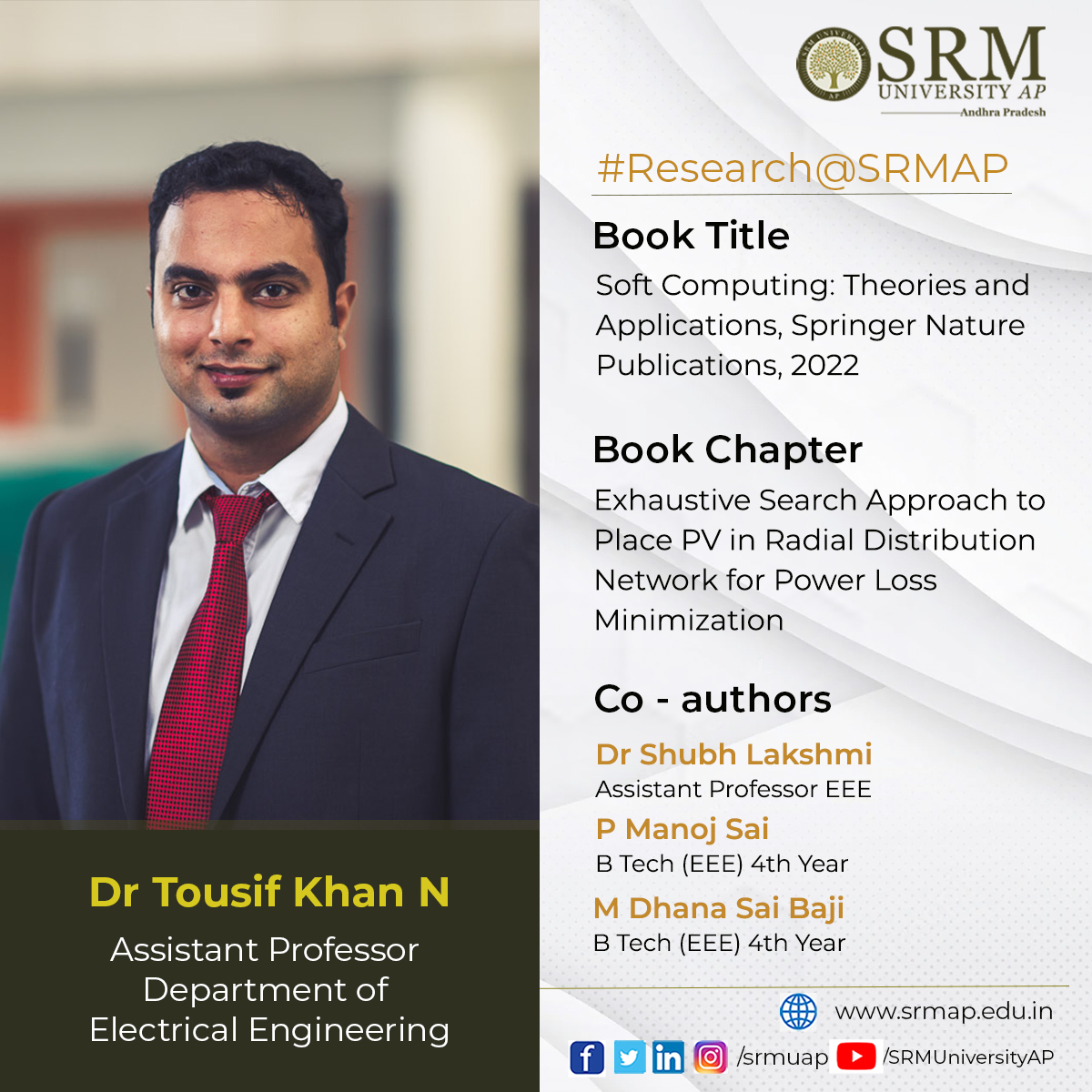 In yet another chapter, “Exhaustive Search Approach to Place PV in Radial Distribution Network for Power Loss Minimization”, co-authored with Dr Shubh Lakshmi, Assistant Professor, and the final year students; P Manoj Sai and M Dhana Sai Baji from the Department of Electrical and Electronics Engineering, an exhaustive search approach to determine the best location and size of PV placement for power loss minimization of radial distribution networks is discussed. In this approach, the network power loss is determined by placing PV in each location, one at a time, and the size of PV in the same location is varied between 10 and 300 kW with an increment of 10 kW.
In yet another chapter, “Exhaustive Search Approach to Place PV in Radial Distribution Network for Power Loss Minimization”, co-authored with Dr Shubh Lakshmi, Assistant Professor, and the final year students; P Manoj Sai and M Dhana Sai Baji from the Department of Electrical and Electronics Engineering, an exhaustive search approach to determine the best location and size of PV placement for power loss minimization of radial distribution networks is discussed. In this approach, the network power loss is determined by placing PV in each location, one at a time, and the size of PV in the same location is varied between 10 and 300 kW with an increment of 10 kW.The combination of location and size of PV which provides the minimum network power loss can be the best location and size of PV for power loss minimization of radial distribution networks. The forward–backward sweep load flow algorithm is used to incorporate the PV model. The 33-bus radial distribution network is used to demonstrate the approach. The simulation results show that the placement of a suitable size of PV in some specific locations significantly reduces the network power loss.
Publishing the latest advancements in Networks and Systems, The LNNS series will serve as an edifying read for all the researchers and scientists across the globe. Volumes published in LNNS give a deep insight into all aspects and subfields of, as well as new challenges in, Networks and Systems. The series encompasses the theory, applications, and perspectives on the state of the art and future developments relevant to systems and networks, decision making, control, complex processes and related areas, as embedded in the fields of interdisciplinary and applied sciences, engineering, computer science, physics, economics, social, and life sciences, as well as the paradigms and methodologies behind them.
- Mechanical engineering students develop multi-utility buggy car June 17, 2022
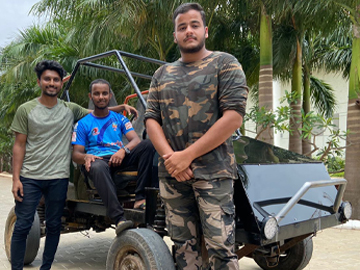 Stories of innovation from SRM AP are not something new! M Tanveer, G Sai Venkat, and Divyansh Awasthi, three vibrant students from the Department of Mechanical Engineering at SRM University-AP, have built a multi-utility buggy car as a part of their final year project work.
Stories of innovation from SRM AP are not something new! M Tanveer, G Sai Venkat, and Divyansh Awasthi, three vibrant students from the Department of Mechanical Engineering at SRM University-AP, have built a multi-utility buggy car as a part of their final year project work.The students initially planned to build a completely new multi-utility vehicle. Later they slightly modified the idea to make a buggy car from scrap materials, i.e. by gathering the efficiently working components from old and unused cars and making them compatible with the chassis.
Motivated by their admiration for the automotive industry, students had great enthusiasm for building the buggy car. They had an urge to convert theoretical knowledge gained from classrooms into practical working machines. Consequently, the trio developed an off-road diesel buggy to show their prowess in the automobile industry, especially on and off-road cars. A Diesel motor is utilised, which is competent in conveying a speed of 50 kilometres per hour.
The chassis of the buggy is designed and manufactured by the students themselves. The spare parts and connection are from the TATA ZIP car model and incorporated into the buggy fitting to the design. The necessary fitting and binding of spare parts are done according to the driving comfort.
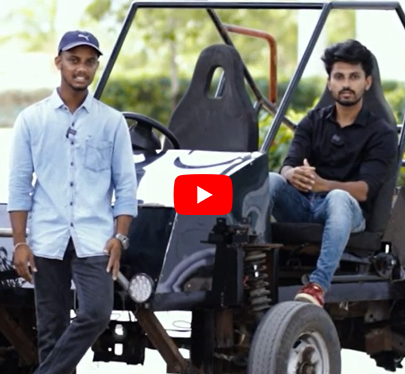
The students expressed their gratitude for the support of their project guide Dr Jasvinder Singh, co-guide Prof Venkata N Nori, and HOD Prof Prakash Jadhav. “We received constant mentorship and guidance throughout our project tenure from them”, said the students. “Whenever we were stuck or were not able to solve a particular problem, or at times were mentally stressed and worn out, our professors gave us proper guidance to warded off our problems and stress, ” they added.
Continue reading → - On an invasive shrub that alters the flora and soils June 16, 2022
 The paper titled “An invasive shrub Lantana camara L. alters the flora and soils in tropical dry deciduous forests of Central India” has been published by Dr Javid Ahmad Dar, Assistant Professor of Environmental Science at SRM University-AP, in “Biotropica” having an impact factor 2.508 (Q1 Journal).
The paper titled “An invasive shrub Lantana camara L. alters the flora and soils in tropical dry deciduous forests of Central India” has been published by Dr Javid Ahmad Dar, Assistant Professor of Environmental Science at SRM University-AP, in “Biotropica” having an impact factor 2.508 (Q1 Journal).Abstract
The findings of this research reveal how an invasive shrub Lantana camara L. significantly alters the flora and soils in tropical dry deciduous forests of Central India and suggested long-term monitoring studies and proper management strategy.
Practical implementation
The findings would be helpful to forest managers, scientists and policymakers for better understanding, management, and restoration of the invaded landscapes in tropical forest ecosystems.
Collaborations
Prof M. L. Khan, Department of Botany, Dr Harisingh Gour Vishwavidyalaya (A Central University), Sagar, Madhya Pradesh, India.
Prof Raman Sukumar, Centre for Ecological Sciences, Indian Institute of Science (IISc), Bengaluru, India.
Prof Mukund Dev Behara, CORAL, Indian Institute of Technology, Kharagpur, West Bengal, India.
Prof S. M. Sundarapandian, Ecology and Environmental Sciences, Pondicherry University, Puducherry, India.Future research plans:
Dr Javid Dar’s research plan for the next five years is to bring together several unique aspects of forest ecology which will be focused on carbon dynamics, mortality, microbial diversity and their relationship in shaping the structure and functional aspects of different forest ecosystems in the on-going and future climate change. Another major aspect of the research will be, to focus on ecophysiology and plant functional trait analysis in forest ecosystems as they are vulnerable to climate change and to see the impacts of climate change on diversity, productivity and stand structure in tropical and temperate forest ecosystems.
Continue reading → - A unique bridging facets assembly of gold nanorods June 15, 2022
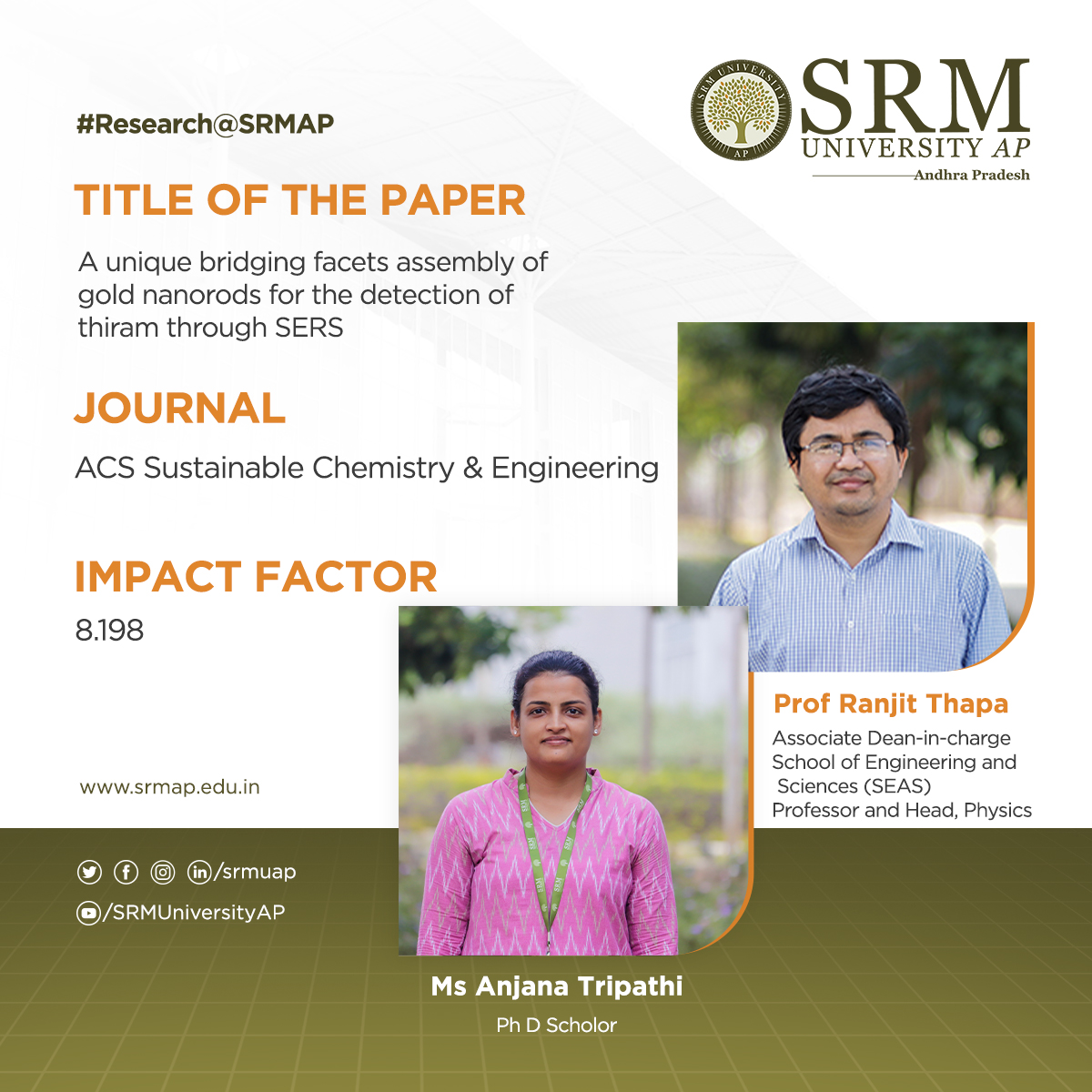 The paper “A unique bridging facets assembly of gold nanorods for the detection of thiram through SERS” has been published by Prof Ranjit Thapa, Professor of Physics and his PhD student, Ms Anjana Tripathi, in ACS Sustainable Chemistry & Engineering having an Impact Factor of 8.198.
The paper “A unique bridging facets assembly of gold nanorods for the detection of thiram through SERS” has been published by Prof Ranjit Thapa, Professor of Physics and his PhD student, Ms Anjana Tripathi, in ACS Sustainable Chemistry & Engineering having an Impact Factor of 8.198.Abstract
The addition of Au NRs (Gold Nanorods) to TRM (Thiram) of higher and lower concentrations, yields side-by-side assembly (SSA) and bridging facets assembly (BFA), respectively, and exhibited excellent hotspots for the ultra-low detection of TRM. Bridging facets of Au NRs, such as (5 12 0) and (5 0 12) planes are mainly responsible for the BFA. This kind of interaction is observed for the first time and not reported elsewhere. The detailed facets of Au NRs, namely side facets, bridging facets, and pyramid facets, were discussed with the 3D model of Au NRs. The computational studies confirm the SSA and BFA for Au NRs with varying concentrations of TRM are well in agreement with the experimental results.
Research in brief
Au NRs were synthesized successfully using the seed-mediated method and characterized by UV-Vis analysis, SEM, TEM, FT-IR, Raman, and XPS analysis. Synthesized Au NRs were employed for the detection of TRM. Upon adding Au NRs to TRM of higher and lower concentrations yields side by side (SSA) and bridging facet assembly (BFA), validated by TEM analysis. This unique BFA was observed for the first time and not reported before to the best of our knowledge. Elemental mapping confirms the good adsorption of TRM over Au NRs, and FT-IR, Raman, SERS, and XPS analysis confirm the adsorption of TRM on Au NRs through Au-S bond. A uniformity study was performed for the TRM-Au NRs sample using 25 random places and obtained an RSD of ≤ 10% for each peak in SERS. This shows TRM is uniformly adsorbed on Au NRs. LOD and EF were achieved at 10 pM and 2.8 ×106, respectively. Hence, Au NRs are considered an excellent substrate for the detection of TRM. The unique assembly of BFA may play a significant role in the research community to further study the facet-dependent interactions of nanostructures. The computational study was performed to know the reason behind SSA and BFA. The density functional theory (DFT) was carried out using the Vienna Ab-initio Simulation Package (VASP). The Perdew-Burke-Ernzerhof (PBE) functional within Generalized Gradient Approximation (GGA) is adopted to treat the exchange-correlation interactions. These studies confirm the formation of a strong bond between Au and S, as well as the SSA and BFA for higher and lower TRM concentrations with Au NRs. The binding energy of TRM in SSA and BFA is -3.81 eV and 3.19 eV respectively. From the theory, it shows that TRM of lower concentration form BFA and higher concentration of TRM, due to high barrier energy for TRM diffusion, Au NRs form SSA. In this respect, we calculated the activation barrier for thiram migration from edge site (BFA) to in between site (SSA). Results indicate that TRM needs 2.40 eV energy to migrate from the edge site to in between site to form side-by-side assembly. Therefore, for diffusion from edge to in between (SSA) site high-energy barrier is required i.e. higher concentration is required for such configuration. Hence, at low concentration, TRM will form bridge facet assembly and due to high barrier energy for TRM diffusion, the side-by-side assembly is possible only at high concentration.
Practical implementation/social implications
Concerns have grown in recent years about the widespread use of the pesticide thiram (TRM), which has been linked to negative effects on local ecosystems. This highlights the critical need for quick and accurate point-of-need pesticide analysis tools for real-time applications. The detection of TRM using gold nanorods (Au NRs) with a limit of detection (LOD) of 10-11 M (10 pM) and an enhancement factor (EF) of 2.8 × 106 along with 6.2% of signal homogeneity (with respect to peak at 1378 cm-1) achieved through surface-enhanced Raman scattering (SERS). The interaction of Au NRs with TRM is sensitive, and ultra-low detection of hazardous TRM through SERS makes an ideal technique for environmental protection, real-time applications, and analysis of one-of-a-kind materials.
Collaborations
Bhavya M. B, Akshaya K. Samal
Continue reading →
Institute: Centre for Nano and Material Sciences, Jain University, Jain Global Campus
Ramanagara, Bangalore 562112, India - Mr Aaditya Jain’s article featured in Brainz magazine June 15, 2022
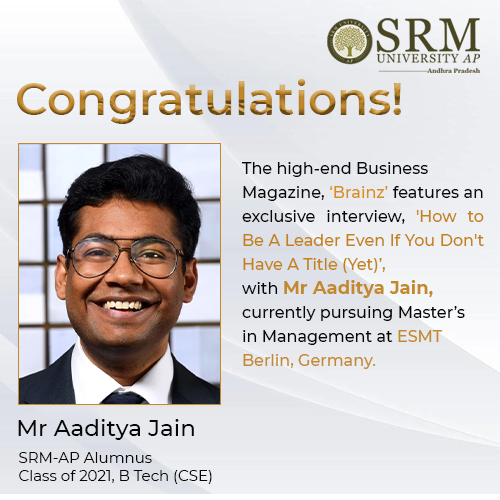
The leaders of tomorrow are defined by the clarity of thought in translating their vision into action. Their words reflect the undying spirit to make it big in life and brace up the world for unforeseen challenges in the times to come. Currently pursuing Master’s in Management at ESMT Berlin, Mr Aaditya Jain, the alumnus of Class of 2021, Computer Science and Engineering, is one such promising leader who is on an endeavour to gear up his personal and professional limits with a solid vision and impeccable work ethic. The high-end Business magazine of Europe, ‘Brainz’ has recently featured his article titled ‘How to Be A Leader Even If You Don’t Have A Title (Yet)’.
Brainz magazine is a global digital periodical that brings influential entrepreneurs, coaches, and business experts to share their knowledge and stories with the world. It features articles across various themes- exploring business innovations, leadership mindsets, aspirational lifestyles, and many more. The magazine aims to disperse inspiring content to augment the quality of life in all aspects. In an interview with Snježana “Ana” Billian, Aaditya shared the top four tips on how to show leadership at work, even if you don’t have a leadership title. As far as he is concerned, one must lead oneself before venturing out to lead others.
Aaditya pronounces the importance of self-awareness as it gives the opportunity to capitalize on one’s strengths and weaknesses to create as much value as possible in every situation. “One of the most powerful things I was told by one of my professors back during my undergrad is: We have all the resources within us. This statement inspired me to embark on a journey of self-discovery” he remarked. Aaditya is also aware of the huge benefit of the internet. Sharing one’s views and experiences online does not require a title. He regularly shares his experience at work and the lessons he learned on leadership online. This makes it easier for him to reach out to like-minded people and create a shared value.
“The need to mould oneself as a proactive communicator and concoct a support network at professional space is essential to ensure one’s career advancement”, says Aaditya. He believes, that asking out for help is a quality that must be encouraged. He further went on to divulge how moving to Germany and settling in was not an easy job. But according to him, the greatest challenge was how to make the most out of it. Success in the words of Aaditya is, “Living my values while continuously growing and inspiring human leadership at work”.
Here is the link to his article: https://www.brainzmagazine.com/post/how-to-be-a-leader-even-if-you-don-t-have-a-title-yet
Continue reading → - Hon’ble Minister Smt Vidadala Rajini inaugurates SRM AP blood donation camp June 14, 2022
Organised in association with the Indian Red Cross Society and STEP Swasakthi Guntur
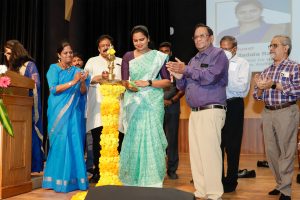 Around 140 students, faculty, non-teaching staff, and administrative members of SRM University-AP participated in the blood donation camp organised as a part of World Blood Donor Day. “You are really fortunate to be a part of this world-class university”, said Chief Guest Ms Rajini Vidadala, Hon’ble Minister for Health & Family Welfare-Government of Andhra Pradesh. She also acknowledged the CSR initiatives and commitment toward social causes by SRM Medical College and Research and the SRM group of institutions.
Around 140 students, faculty, non-teaching staff, and administrative members of SRM University-AP participated in the blood donation camp organised as a part of World Blood Donor Day. “You are really fortunate to be a part of this world-class university”, said Chief Guest Ms Rajini Vidadala, Hon’ble Minister for Health & Family Welfare-Government of Andhra Pradesh. She also acknowledged the CSR initiatives and commitment toward social causes by SRM Medical College and Research and the SRM group of institutions.In his presidential address, Pro-Vice-Chancellor Prof D Narayana Rao talked about the virtue of regular, voluntary, and unpaid blood donations. He further highlighted SRM University-AP’s achievements in building next-generation world-class scientists and innovators. He narrated the university’s commitment to creating a conducive research ecosystem.
World Blood Donor Day is observed on June 14 every year around the world to promote awareness about the need for safe transfusion and honour blood donors for their selfless act of saving lives. This year WHO observes the day on the theme “Donating blood is an act of solidarity. Join the effort and save lives”.
“This is the fourth time I am donating blood from SRM AP. I feel so proud and happy to be a part of this noble deed,”- says Ms Shalini Jayakumar, Assistant manager- Office of Examinations. She also encouraged women to come forward and donate blood without the fear of after-effects.
Certificates were distributed to the benevolent blood donors of SRM University-AP. Prof D Narayana Rao felicitated the Hon’ble Minister with a memento for her prolific contributions to society. The blood donation camp was organised in association with the Indian Red Cross Society (IRCS) and STEP Swasakthi Guntur. Addressing the gathering, Ramachandra Raju- Vice Chairman, IRCS Guntur, appreciated the non-teaching staff for being the leading light to students. NSS Coordinator of the university, Dr Lakshman Rao and Programme Officer Dr Pardha Saradhi Maram highlighted the role of blood donation in saving lives.
Dr R Premkumar-Registrar, Ms Suma N- Chief Finance and Accounts Officer (CFAO), Ms Revathi Balakrishnan- Student Affairs Assistant Director, Deans and Associate Deans of various schools, and Directors and Associate Directors of different departments were present at the meeting held at the university auditorium.
Continue reading → - Enhanced charge transport behaviour of protein-metal nanocluster hybrid June 14, 2022

Proteins are the most vital life forms which maintain close coordination with almost living activities through their biological functions. Nevertheless, in most cases, proteins suffer from low charge (electron) transfer efficiency as they are mainly made of insulating organic molecules. The interdisciplinary research publication, of Dr Sabyasachi Mukhopadhyay and Dr Sabyasachi Chakrabortty from the Department of Physics & Department of Chemistry respectively, along with their PhD scholars: Ms Ashwini Nawade, Mr Kumar Babu Busi and Ms Kunchanapalli Ramya, envisions the molecular-level understanding of the charge transport behaviour of various protein-metal nanocluster hybrid.
The article titled ‘“Improved Charge Transport across Bovine Serum Albumin – Au Nanoclusters’ Hybrid Molecular Junction” was featured in the prestigious Q1 journal ACS Omega (IF: 3.512), published by the ‘American Chemical Society’. They successfully incorporated Gold Nanoclusters inside the protein backbone leading to an increase in their conductivity. This will provide new avenues for the rational design of bioelectronic devices with optimized features. The BSA-Au cluster has been a promising model for bioelectronic functionalities. With an increase in their current carrying capacity, they can be used for many more applications, especially as the interface between tissue and organ in biocompatible devices. The research team is also planning to work with various protein dopants to understand their charge transport mechanism. These studies will help in using the protein for various applications mainly in bioimplants or biosensors for drug testing and diagnostics purposes.
Abstract of the Research
Proteins, a highly complex substance, have been the essential element in the living organism where various applications are envisioned due to their biocompatible nature. Apart from protein’s biological functions, contemporary research mainly focuses on their evolving potential associated with nanoscale electronics. Here, we report one type of chemical doping process in model protein molecules (BSA) to modulate its electrical conductivity by incorporating metal (Gold) nanoclusters on the surface or within it. The as-synthesized Au NCs incorporated inside the BSA (Au 1 to Au 6) were optically well characterized with UV-Vis, time-resolved photoluminescence (TRPL), X-ray photon spectroscopy, and high-resolution transmission electron microscopy techniques. The PL quantum yield for Au 1 is 6.8% whereas Au 6 is 0.03%. In addition, the electrical measurements showed ~10-fold enhancement of conductivity in Au 6 where maximum loading of Au NCs was predicted inside the protein matrix. We observed a dynamic behaviour in the electrical conduction of such protein-nanocluster films, which could have real-time applications in preparing biocompatible electronic devices.
Continue reading → - Recovery of nutrients from wastewater June 14, 2022

Water pollution continues to be one of the serious concerns facing the country. The ensuing scenario of eutrophication and harmful algal blooms has exacerbated the menace. This demands wholescale water management techniques to segregate the pollutants, retrieve useful nutrients, and treat the water effectively for sustainable use. Dr Karthik Rajendran and his PhD scholar, Mr Sarath Chandra, from the Department of Environment Science have published a paper discussing various nutrient recovery methods and their consequential outcomes. The research was done in collaboration with Dr Deepak Kumar from SUNY College of Environmental Science and Forestry, Syracuse, NY and Dr Richen Lin from Southeast University, Nanjing, China.
The article titled, “Nutrient recovery from wastewater in India: A perspective from mass and energy balance for a sustainable circular economy” was published in Bioresource Technology Reports (Q1 Journal), having an Impact Factor of 4.41. Their research investigates the possibilities of recovering Nitrogen (N) and Phosphorous (P) from wastewater in terms of technology, energy, and economic point of view. Excessive presence of Nitrogen and Phosphorous can result in eutrophication and algal blooming. These nutrients also pose a harmful threat to infrastructure. Nutrient recovery can mitigate these challenges and improve the quality of water.
Phosphorus is one of the limited resources available on earth and a key ingredient in fertilizer production. The recovery process also helps in transforming wastewater into resource pools that can efficiently churn out valuables that hold the key to a sustainable future. This will help reduce the imports of fertilizers and bring down the emissions to half in producing fertilizers. Their findings will also pave the way for making necessary policies to reduce water pollution and recover nutrients. As two-thirds of wastewater remains uncollected, they claim that effective treatment and water management practices can save around 800 crores per annum. Their future research plan also includes the experimental analysis of the nutrient recovery system.
Abstract of the Research
Wastewater (WW) is a potential source to recover N, and P, whereas, in India, it is scarcely explored. In this work, four different nutrient recovery methods were compared from a mass- and energy-balance perspective to understand the overall process flow. From 1000-m3 WW, chemical precipitation yielded 33.8 kg struvite, while micro-algae resulted in 299.1 kg (dry powder). Energy consumption was lowest for the fuel cells at 216.2 kWh/1000 m3, while microalgae used the highest energy at 943.3 kWh/1000 m3. Nonetheless, the cost-saving analysis showed that microalgae (78.6$/1000 m3) as a nutrient recovery choice, had higher savings than any other methods compared. For a country like India, where two-thirds of urban wastewater is untreated, wastewater-biorefinery options such as nutrient recovery hold the key to a sustainable circular economy.
- Comparing organic food preferences of American and Indian consumers June 13, 2022
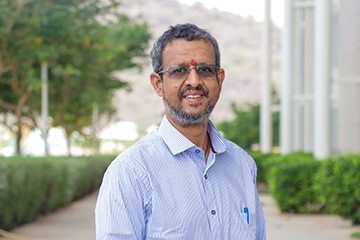
A paper titled “Organic food preferences: A comparison of American and Indian consumers” has been published by Prof Bharadhwaj Sivakumaran, Dean- SEAMS, SRM University-AP, Kirubaharan Boobalan (SSN College of Engineering), and Margaret Susairaj (Great Lakes Institute of Management, Chennai) in the journal Food Quality and Preference having an Impact Factor of 5.6.
This research tests a nomological model predicting organic food attitudes and purchase intentions in USA and India. Data were collected from India (n = 687) and the USA (n = 632) using Amazon M Turk and were analyzed using structural equation modelling and multi-group moderation technique. Results revealed that over and above attitude, subjective norm and perceived behavioural control, response efficacy and self-expressive benefits significantly affect consumers’ attitudes and purchase intentions toward organic food among American and Indian consumers. Findings reveal that response efficacy and attitude matter more in the USA while subjective norms and self-expressive benefits exert a greater influence in India. Therefore, marketers may reinforce belief-related elements while selling organic food products in the USA and societal-related elements while selling in India. Theoretically, this work adds to the Theory of Planned Behavior by adding self-expressive benefits and develops a common model for organic food across samples in USA and India.
Continue reading → - Food safety applications of surface-enhanced Raman Spectroscopy June 10, 2022
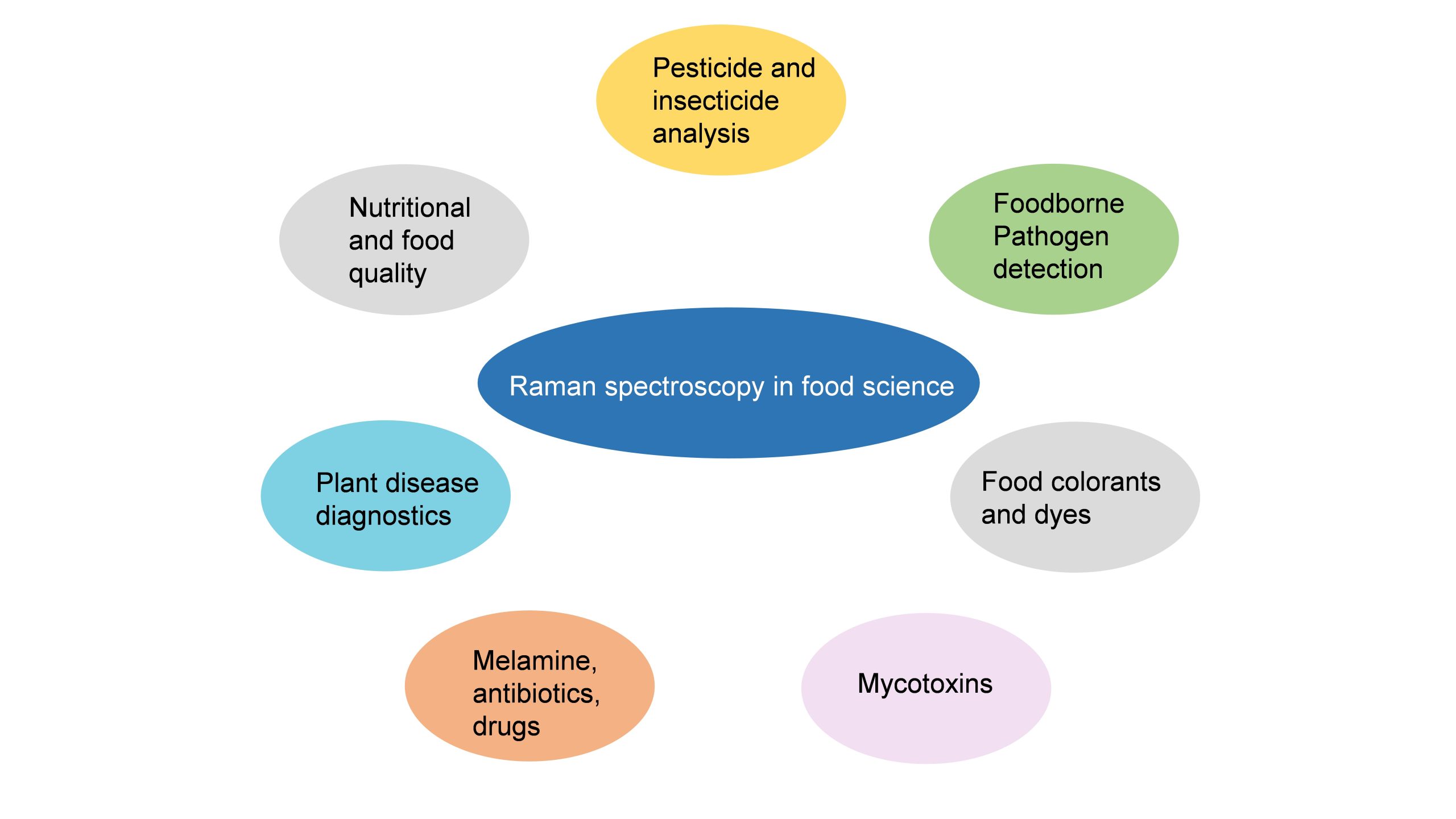
Surface-enhanced Raman Spectroscopy (SERS) is a nuanced chemical technique that amplifies the Raman scattering of molecules by utilising plasmonic nanostructured materials. SERS operates as a powerful detection tool that allows for the structural fingerprinting of a molecule. The ultra-high sensitivity and selectivity of the process offer it a vast array of applications in surface and interface chemistry, nanotechnology, biology, biomedicine, food science, environmental analysis and other areas.
Dr J P Raja Pandiyan and his PhD scholar, Ms Arunima Jinachandran from the Department of Chemistry have been keenly involved in exploring the possibilities of SERS technology in food science and other fields. The safety and quality concerns related to food were the primary reasons that impelled them to step into this domain. Their article “Surface-enhanced Raman spectroscopy for food quality and safety monitoring” was published in the book Nanotechnology Applications for Food Safety and Quality Monitoring, published by Elsevier. The article was published in collaboration with Dr Selvaraju Kanagarajan from the Swedish University of Agricultural Sciences.
Continue reading →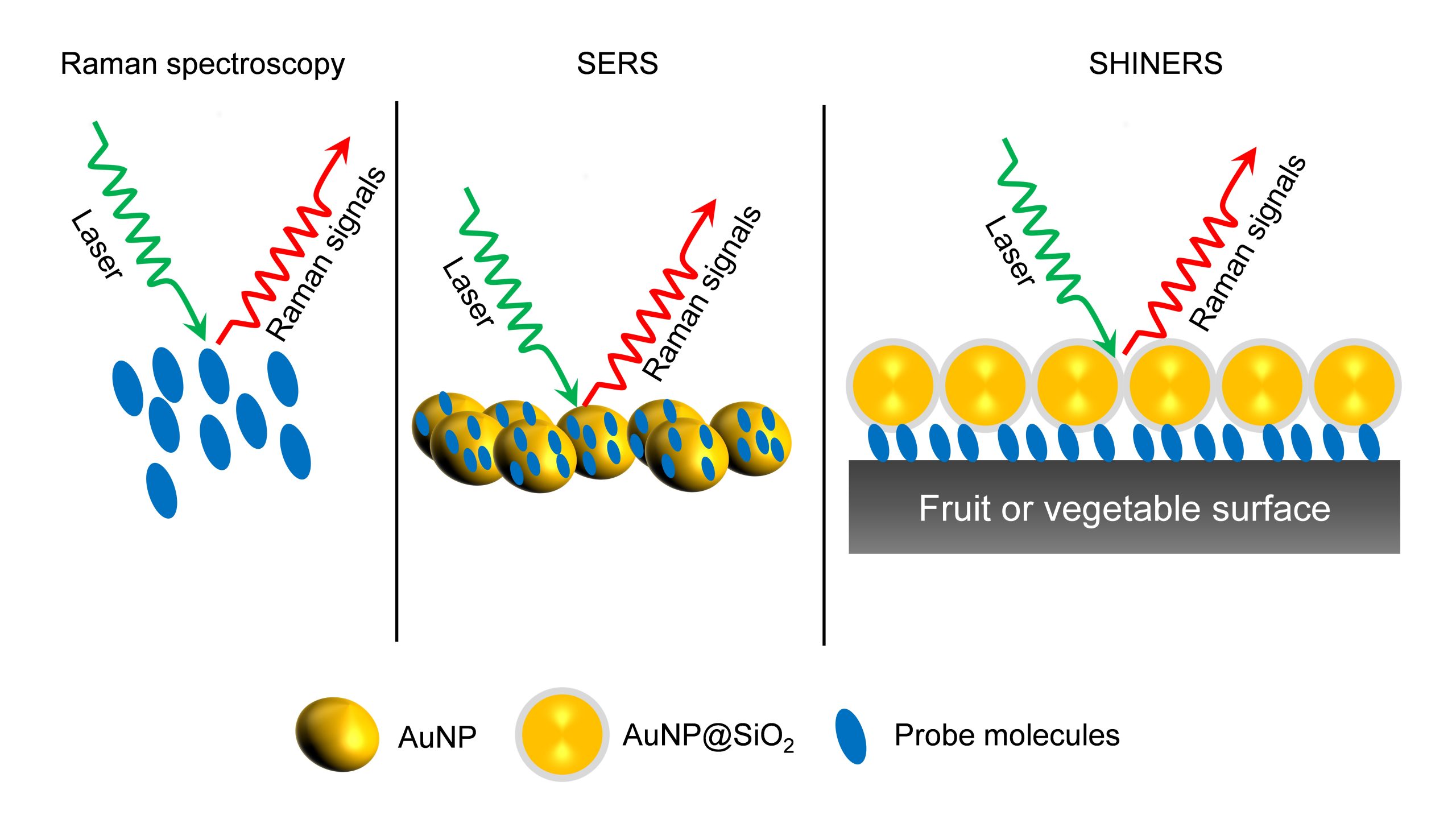 As an analytical technique, SERS possesses several advantages such as non-destructive, sensitive, and selective. In the chapter, the necessity, and applications of SERS in food science are elaborately discussed. They have also discussed all the possible food contaminants and how to identify them using SERS to ensure food quality. This book will serve as an enlightening read to research groups who are working on Raman, surface-enhanced Raman spectroscopy, analytical chemistry, and food quality analysis.
As an analytical technique, SERS possesses several advantages such as non-destructive, sensitive, and selective. In the chapter, the necessity, and applications of SERS in food science are elaborately discussed. They have also discussed all the possible food contaminants and how to identify them using SERS to ensure food quality. This book will serve as an enlightening read to research groups who are working on Raman, surface-enhanced Raman spectroscopy, analytical chemistry, and food quality analysis.

